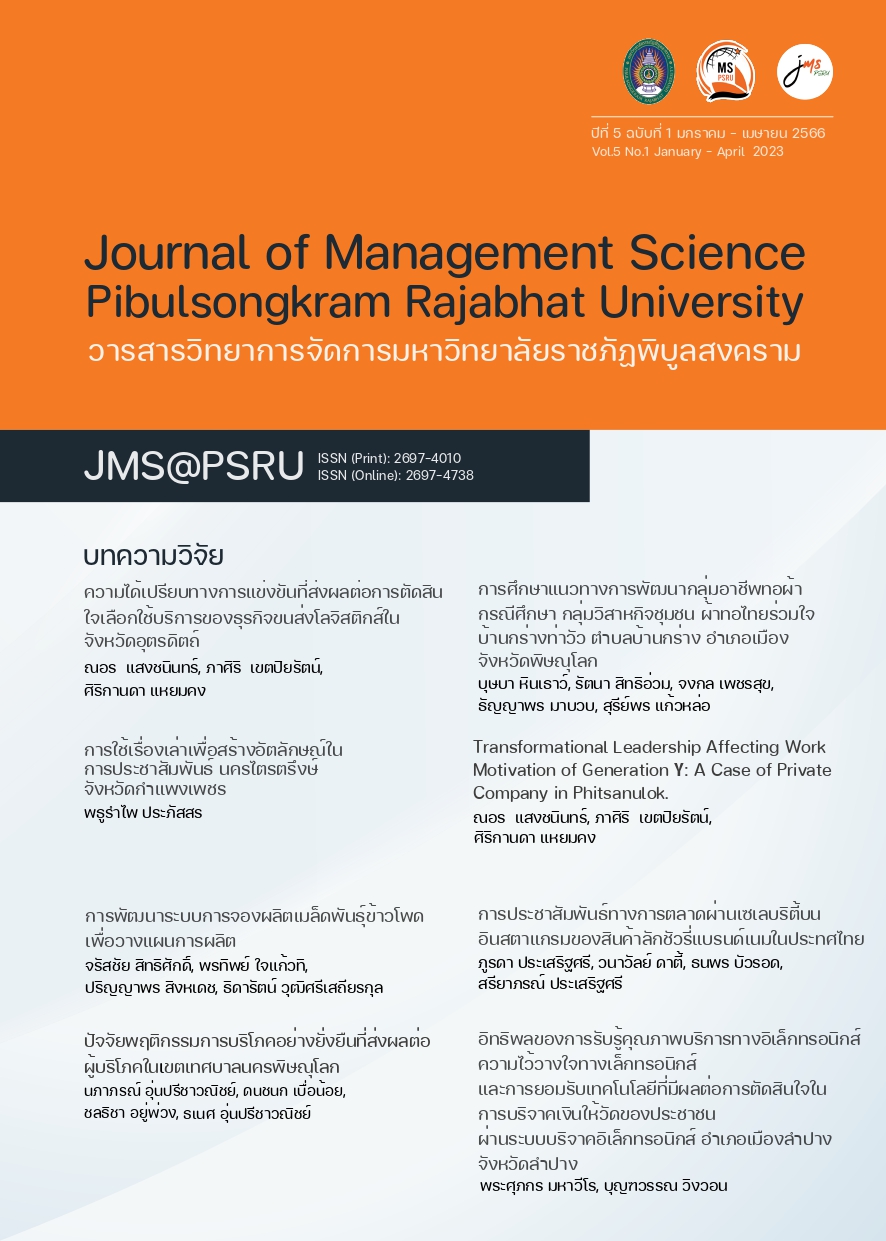Effect of Electronic Service Quality Perceived, Electronic Trust, and Technology Acceptance toward the Decision Making to Donate Money for the Temple of the People through the Electronic Donation System in Mueang Lampang District, Lampang Province
Keywords:
e-Service Quality, e-Trust, Technology Acceptance, Decision Making, e-DonationAbstract
The objectives of the research were 1) to study the importance of electronic service quality perceived, electronic trust, and technology acceptance toward decision-making, and 2) to study the effect of electronic service quality perceived, electronic trust, and technology acceptance toward the decision making to donate money to the temple of the people through the electronic donation system in Mueang Lampang District, Lampang Province. The sample group was 384 people who have donated and lived in Lampang Province. The research instrument used a questionnaire to analyze the data by descriptive statistics for percentage, mean, and standard deviation. Inferential statistics were analyzed with correlation and multiple regression by Enter Selection technique.
The results of the research showed that 1) all factors had the most importance. The factors very important are technology acceptance, followed by the electronic service quality perceived, electronic trust and decision making, and 2) Electronic trust had a direct influence on most decision-making with a regression coefficient equal to 0.457, followed by the electronic technology acceptance had a direct influence decision-making with a regression coefficient equal to 0.426 and found a statistical significance at 0.05. As for the electronic service quality perceived no direct influence on the decision to donate money to the temples of the people through the electronic donation system.
References
กรมสรรพากร. (2564). คู่มือระบบบริจาคอิเล็กทรอนิกส์ (e-Donation) เวอร์ชั่น 2. สืบค้น 29 กรกฎาคม 2565, จาก https://www.chula.ac.th/wp-content/uploads/2019/10/ManualeDonationV2.pdf
ณัทฐาพร ภู่ระหงษ์. (2565). ปัจจัยที่ส่งผลต่อความตั้งใจใช้บริการการเงินส่วนบุคคลด้วยแอปพลิเคชันธนาคารในจังหวัดมหาสารคาม. วารสารวิทยาการจัดการมหาวิทยาลัยราชภัฏพิบูลสงคราม, 4(3), 116-130
พิชชาภา ใบศรี. (2562). การตัดสินใจใช้งานระบบการชำระเงินอิเล็กทรอนิกส์ e-Money (Electronic Money) ในการซื้อสินค้าของผู้บริโภคในเขตกรุงเทพมหานคร. สืบค้น 29 กรกฎาคม 2565, จาก https://mmm.ru.ac.th/MMM/IS/vlt15-2/6114993299.pdf
ภวัต นิธิโชติภาคิน. (ม.ป.ป.). ปัจจัยและนโยบายที่ส่งผลต่อการตัดสินใจบริจาคเงินผ่านระบบบริจาคอิเล็กทรอนิกส์ (e-Donation). สืบค้น 10 สิงหาคม 2565, จาก https://econ.nida.ac.th/wp-content/uploads/2021/05/4-10-Abstract-6210323028.pdf
ภานุพงศ์ ลือฤทธิ์. (2560). คุณภาพการบริการอิเล็กทรอนิกส์ในการสร้างความพึงพอใจของผู้ใช้งาน: กรณีตัวอย่างของแอปพลิเคชันกระเป๋าเงินบนโทรศัพท์มือถือ (การค้นคว้าอิสระ). กรุงเทพฯ: มหาวิทยาลัยธรรมศาสตร์.
มัณฑนา โพธิ์แก้ว. (2550). ความคิดเห็นของบุคลากรที่มีต่อการบริหารงานขององค์การบริหารส่วนตำบลในเขตอำเภอแหลมสิงห์ จังหวัดจันทบุรี (วิทยานิพนธ์ปริญญามหาบัณฑิต). ชลบุรี: มหาวิทยาลัยบูรพา.
มานัส ตัญญาภักดิ์ และชฎาพร ฑีฆาอุตมากร. (2561). การเปรียบเทียบระบบการบริจาคในรูปแบบกระดาษกับ e-Donation เพื่อใช้สิทธิ์ลดหย่อนภาษีเงินได้ของประชาชนในเขตกรุงเทพมหานคร (การค้นคว้าอิสระ). กรุงเทพฯ: มหาวิทยาลัยรามคำแหง.
สำนักงานคณะกรรมการข้าราชการพลเรือน. (2565). Digital Disruption และมาตรการรับมือด้าน HR ของภาครัฐ. สืบค้น 29 กุมภาพันธ์ 2566, จาก https://www.ocsc.go.th/sites/default/files/digital_disruption-article-ocsc-feb2020.pdf
Ajzen, I. (1985). From intention to actions: A theory of planned behavior. Action control: From cognition to behavior. Berlin: Springer-Verlag.
Ajzen, I., & Fishbein, M. (1980). Understanding Attitudes and Predicting Social Behavior. Englewood Cliffs, NJ: Prentice-Hall.
Barnard, C. I. (1938). The functions of the executive. Cambridge, MA: Harvard University Press.
Best, J. W. (1977). Research in Education (3rd ed). New Jersey: Prentice-Hall.
Corbitt, B. J., Thanasankit, T., & Yi, H. (2003). Trust and e-commerce: a study of consumer perceptions. Electronic Commerce Research Applications, 2(3), 203-215.
Cochran, W. G. (1977). Sampling Techniques (3rd ed.). New York: John Wiley & Sons.
Cronbach, L. J. (1970). Essentials of Psychological Test (5th ed.). New York: Harper Collins.
Davis, F. D. (1989). Perceived usefulness, perceived ease of use, and user acceptance of information technology. MIS Quarterly, 319-340.
Davis, F. D., Bagozzi, R. P., & Warshaw, P. R. (1989). User Acceptance of Computer Technology: A Comparison of Two Theoretical Models. Management Science, 35(8), 982-1003.
Gefen, D., Karahanna, E., & Straub, D. W. (2003). Trust and TAM in online shopping: An integrated model. MIS Quarterly, 27(1), 51-90.
Gefen, D., & Straub, D. W. (2004). Consumer trust in B2C e-Commerce and the importance of social presence: experiments in e-Products and e-Services. Omega, 32(6), 407-424.
Johnston, E. (2013). 5 Steps to Understanding Your Customer’s Buying Process. Retrieved July 29, 2022, from https://www.b2bmarketing.net/en-gb/resources/blogs
Kim, J., & Lee, J. (2006). Critical design factors for successful e-commerce systems. Behavior & Information Technology, 21(3), 185-199.
Kotler, P. (2000). Marketing Management (10th ed.). New Jersey: Prentice-Hall.
Li, Y., Tan, K. C., & Xie, M. (2002). Measuring web-based service quality. Total quality management, 13(5), 685-700.
Maslow, A. H. (1987). Motivation and personality (3rd ed.). Harper & Row Publishers.
Parasuraman, A., Zeithaml, V. A., & Berry, L. (2005). ES-QUAL: A multiple-item scale for assessing electronic service quality. Journal of Service Research, 7(3), 213-233.
Rovinelli, R.J. & Hambleton, R.K. (1976) On the Use of Content Specialists in the Assessment of Criterion-Referenced Test Item Validity. Washington: Educational Resources Information Center.
Simon, H. A. (1960). The New Science of Management Decision. Harper & Brothers. Retrieved 07 29, 2022, from https://doi.org/10.1037/13978-000
Simon, H. A. (1966). Administrative Behavior: A Study of Decision Making Process in Administrative Organization. Toronto: The Free Press.
Stewart. (1999). Empowering People. London: Pitman publishing.
Venkatesh, V., Morris, M.G., Davis, G.B., & Davis, F.D (2003). User acceptance of information technology: Toward a unified view. MIS Quarterly, 27(3), 425-478.
Downloads
Published
How to Cite
Issue
Section
License
Copyright (c) 2023 Pibulsongkram Rajabhat University

This work is licensed under a Creative Commons Attribution-NonCommercial-NoDerivatives 4.0 International License.
บทความที่ได้รับการตีพิมพ์ในวารสารวิทยาการจัดการมหาวิทยาลัยราชภัฏพิบูลสงคราม เป็นลิขสิทธิ์ของมหาวิทยาลัยราชภัฎพิบูลสงคราม
บทความที่ลงพิมพ์ใน วารสารวิทยาการจัดการมหาวิทยาลัยราชภัฎพิบูลสงคราม ถือว่าเป็นความเห็นส่วนตัวของผู้เขียนคณะบรรณาธิการไม่จำเป็นต้องเห็นด้วย ผู้เขียนต้องรับผิดชอบต่อบทความของตนเอง


